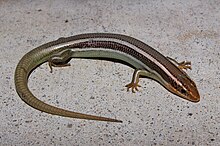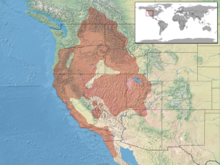Western skink
| Western skink | |
|---|---|
 |
|
| Scientific classification | |
| Kingdom: | Animalia |
| Phylum: | Chordata |
| Subphylum: | Vertebrata |
| Class: | Reptilia |
| Order: | Squamata |
| Suborder: | Lacertilia |
| Infraorder: | Scincomorpha |
| Family: | Scincidae |
| Subfamily: | Scincinae |
| Genus: | Plestiodon |
| Species: | P. skiltonianus |
| Binomial name | |
|
Plestiodon skiltonianus Baird & Girard, 1852 |
|
 |
|
| Synonyms | |
|
|
The western skink (Plestiodon skiltonianus) is a species of small, smooth-scaled lizard with relatively small limbs. It measures about 100 to 210 mm (about 4 to 8.25 inches) in total length (body + tail). It is one of five species of lizards in Canada. They spend much of their day basking in the sun. Their diet ranges widely, including spiders and beetles. Western skinks will bite if grasped and will flee if they feel threatened. It is a common but secretive species whose range extends throughout Washington, Oregon, Nevada, Utah, and Wyoming and into western Montana and northern Arizona.They can also live in some areas of Texas It is widespread in northern California but primarily restricted to the coast in central and southern California. Found in a variety of habitats, this lizard is most common in early successional stages or open areas of late successional stages. Heavy brush and densely forested areas are generally avoided. Western skinks are found from sea level to at least 2,130 m (7,000 ft). This diurnal reptile is active during the warm seasons.
Initially described in 1852 by Baird and Girard, the Western skink is named for Dr. Avery Judd Skilton (1802–1858), an American physician and naturalist, who collected the first specimens. Together with Gilbert's skink (P. gilberti), the San Lucan skink (P. lagunensis), and the four-lined Asiatic skink (P. quadrilineatus), the western skink belongs to the so-called "skiltonianus group". The exact taxonomy within this group has yet to be conclusively determined, and may need revision following DNA analysis research.
...
Wikipedia

